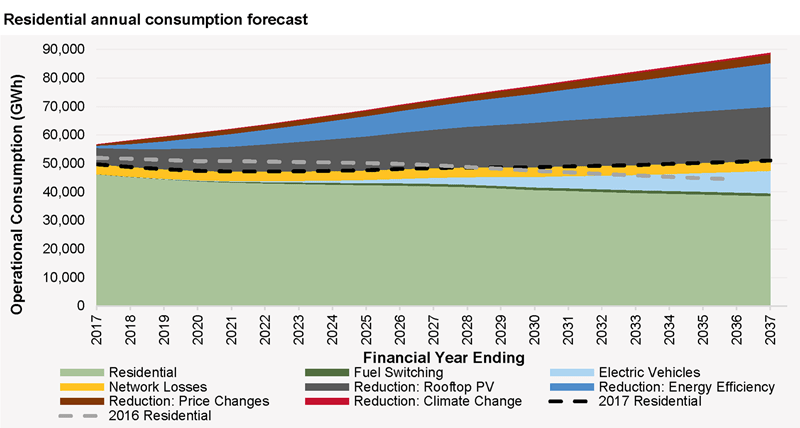Residential consumption
Key insights
- NEM-wide, residential annual consumption as delivered to households (that is, excluding any network losses) is forecast to fall by 4.8% (or 1.0% pa) from 46,260 GWh in 2016–17 to 44,033 GWh in 2021–22, but to grow moderately by 3.9% (or 0.2% pa) to 48,059 GWh over the 20-year forecast period. In addition to traditional residential consumption, this includes consumption from electric vehicles (EVs).
- While electricity is used for an increasing number of appliances, forecast growth in delivered consumption is projected to be offset by household energy generation from rooftop photovoltaics (PV) and use of more energy-efficient appliances. Improved building energy efficiency will also reduce demand for space cooling and heating.
- A projected climate warming trend is forecast to reduce heating consumption but increase cooling consumption, resulting in a net reduction in annual residential delivered consumption of 0.2% in the short term (to 2021–22) and 1.1% in the longer term (to 2036–37).
- Under the Strong scenario, driven by projected stronger growth in new dwellings and more rapid forecast uptake of EVs, residential annual consumption NEM-wide is forecast to grow by 19.0% (or 0.9% pa) over the 20-year forecast period. Weaker assumed growth in new dwellings and ramp up rate of EVs under the Weak scenario results in forecast annual consumption falling by 5.6% in the short term and 6.7% over the long term.

Regional insights
Residential annual delivered consumption forecasts for individual NEM regions differ from NEM-wide trends in the following ways.
New South Wales
Relative to the NEM-wide trend, consumption is forecast to reduce by a lower rate of 4.5% over the short term, driven by stronger new connection growth projections. Over the long term, forecast growth is only 2.0%, due to forecast higher uptake of rooftop PV offsetting the projected growth in connections.
Queensland
Consumption is forecast to reduce by a much lower rate of only 1.1% over the short term, primarily driven by higher projected uptake of cooling appliances. Over the longer term, annual consumption is forecast to grow by 12.3%, with forecast continued strong penetration of cooling appliances more than offsetting projected reductions due to rooftop PV. Queensland is the only NEM region with a net forecast increase in cooling consumption due to the projected effect of climate weather warming.
South Australia
This is the only NEM region with negative short-term and long-term projected growth, of -13% and -17.5% respectively. South Australia is forecast to have the slowest growth in new connections, and, at the same time, the strongest uptake of rooftop PV in the NEM.
Tasmania
While consumption is projected to reduce by 2.5% over the short term, it is forecast to grow by 11.7% over the longer term. Projections for low new connection growth and low appliance update are the key drivers of the forecast short-term consumption reduction. The projected climate warming trend has a more noticeable role in this region, reducing forecast annual consumption by 4.7% over the longer term. Forecast saturation of rooftop PV uptake is the key driver behind the longer-term projected growth in annual consumption.
Victoria
Consumption is projected to reduce by 6.7% over the short term, driven by weaker forecast construction activities so lower growth in new connections along with increasing uptake of rooftop PV and increasing energy efficiency measures. The stronger growth of 4.5% longer term to 2036–37 is driven by projected increased uptake of EVs and gas-to-electric appliance fuel-switching.






